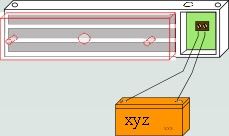© 2011 door-

Consist of the following items:-
Securing Plate (1) with various fixing holes of which two off are elongated for a reason, and also a cable wiring hole.
Magnetic Lock (2) containing the coils which can be a very heavy item and should be "handled with care" as injury can occur. To gain access to the Electrical connections to energise the coils. Removal of plate (2 a) is necessary
Armature (3) which again is a heavy item, this is mainly made of a solid piece of mild steel which sometimes is nickel coated for aesthetic reasons.

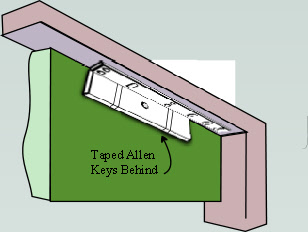

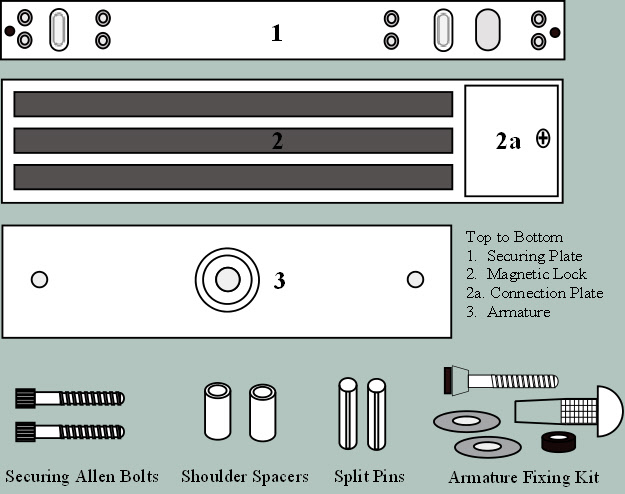
Shoulder Spacers are used to sleeved the securing allen bolts. They MUST BE FITTED. Their purpose is to increase the rigidity of the Magnet Lock when fitted. Without these, the continual closing of the door can cause the Securing Allen Bolts to slacken or shear off.
Split Pins are inserted in the armature and stop the armature spinning on its central main securing bolt. They also help in alignment of the armature to the magnetic lock.
Armature Fixing Kit consist of two steel washers, a rubber spacer, a central fixing allen bolt and a blind dome head female internally threaded bolt, with a knurled exterior on the outer shaft.
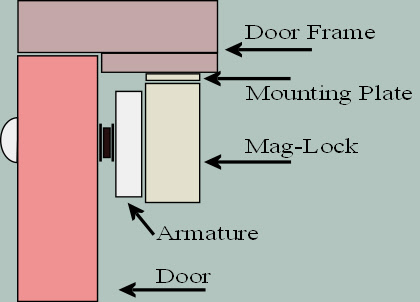
When fitting a magnetic lock to a door frame various accounts have to be taken into consideration. Is it a left or a right hand opening door. Is it an outward or an inward opening door. The door construction aluminium, wood, glass etc. Metal and Glass doors generally require more fitting time especially if surrounded by glass
No matter what the door type, you should always fit the magnetic lock on the ‘secure’ side of the door. This prevents tampering of the lock by others.
There are three measurements to consider when fitting the lock.
As you can see from this example, there is shown two Major measurements which must be quite accurate. These measurements ensure the door when closed with the armature fitted shall make contact with the magnetic lock and lock the door.
The distance from the door (when closed) to the securing plate is :-
The thickness of 2 Metal Washers + Rubber Spacer + Armature
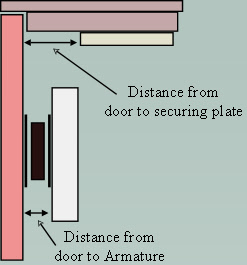
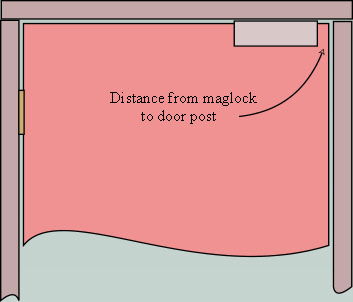
Overall instructions
1. Check the door condition that it is sound and fits squarely in the door frame also the hinges are tight and not worn.
A mag lock once fitted to a badly fitting door can cause grief once the customer decides to repair the door. You shall be asked to return due to the door is not locking correctly.
2. Fit the mag lock first, being careful to measure distances
3. Power up the mag lock from a power supply (its permanent power supply or a temporary battery).
3. Fit PINS into the Armature
4. Place the Armature against the powered-
5. Rub a marking material on the end of the Armature Pins. (Chalk, Pencil, Tipex etc) or place a piece of tape on the door approximately where the pins shall touch the door. On a wooden door you can press the door to the Armature.
6 Now close the door lightly onto the Armature. The position of one of the Armature Pins should now be showing on the door.
7 Drill this position with a 6 mm drill approximate to the depth of the Pins.
8. Now close the door lightly onto the Armature. The first Armature Pin should now slot into the newly drilled hole. Closing the door further should show the position of the second Armature Pins showing on the door.
8. Again drill this position with a 6 mm drill approximate to the depth of the Pins.
9. Now release the Armature from the holding Mag lock.
10 Place the Armature onto the door with the Pins in the newly drilled holes.
This now gives you the exact centre to drill the Large Armature Bolt Centre Hole
Details Of Fitting a Magnetic Lock
With the door closed, hold the armature against the door with the securing plate adjacent as shown.
With both held in place and the 3rd measurement (distance from the vertical door post), mark the door transom through the two elongated holes in the securing plate.
You only have to mark the centres of the two elongated hole as this allows flexability for the final fixing
Mark the cable entry hole through the securing plate and drill the cable entry through the door transom.
Fit the Maglock to the Securing Plate and power-
